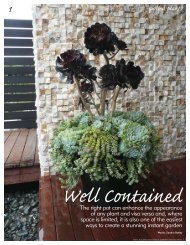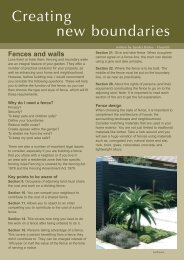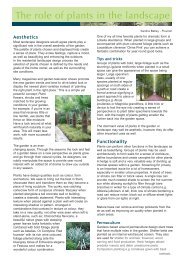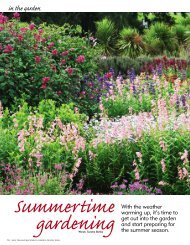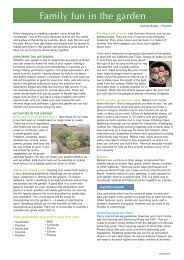You also want an ePaper? Increase the reach of your titles
YUMPU automatically turns print PDFs into web optimized ePapers that Google loves.
Gardens | <strong>Trees</strong><br />
Silk Tree<br />
<strong>The</strong> <strong>Beauty</strong> <strong>of</strong> <strong>Trees</strong><br />
Selecting the right tree for your own piece <strong>of</strong> paradise can be difficult.<br />
Sandra Batley guides us through what to consider and <strong>of</strong>fers some handy<br />
hints when planting one in your own garden.<br />
Most people love the scenic<br />
beauty <strong>of</strong> trees in the landscape. What<br />
would be a landscape without them?<br />
<strong>The</strong>y improve the quality <strong>of</strong> air we<br />
breathe and they beautify our homes,<br />
parks, cities and landscapes.<br />
But, when you are planting them<br />
in your garden they can block drains,<br />
cast shadows, hide important views,<br />
undermine walls and foundations and<br />
cause a real headache. That is why it is<br />
vital that you choose the right tree for<br />
the right place and take responsibility<br />
for ensuring your own trees do not<br />
cause problems for anyone else now or<br />
in the future.<br />
What to consider<br />
In a small suburban garden, trees<br />
provide structure and height. However<br />
there are a few things to think about<br />
before rushing out and buying ‘just<br />
any old tree’ to plant in your backyard.<br />
If there is one major mistake people<br />
make in their gardens, it is that they<br />
forget that plants grow! Consider<br />
carefully the mature size and shape <strong>of</strong><br />
the trees you want to plant. It is best to<br />
consult with your landscape designer<br />
or staff at your local garden centre to<br />
help you choose the right tree for your<br />
particular situation.<br />
ABOVE RIGHT clearing leaves can be a<br />
lot <strong>of</strong> work with deciduous trees.<br />
FAR RIGHT <strong>The</strong> silk tree with its fluffy<br />
pink flowers is great in warmer climates.<br />
Screening and privacy<br />
<strong>Trees</strong> can provide privacy for your home<br />
and outdoor living areas. Evergreen<br />
trees are best if you require screening.<br />
However, you do need to be very careful<br />
about what type <strong>of</strong> tree you plant.<br />
Planting a tree that eventually grows<br />
too big for the space or is too close<br />
to you or your neighbour’s home can<br />
cause problems. If the trunk <strong>of</strong> the tree<br />
extends over the boundary, this does<br />
not give you the right to chop it down.<br />
A tree planted on your neighbour’s<br />
land belongs to them, and they will be<br />
liable for any damage it causes. If your<br />
neighbour’s tree is causing problems,<br />
the first step is to talk to them. A<br />
mutually agreeable solution will<br />
certainly be preferable to a lengthy and<br />
costly legal battle.<br />
Provide shade and shelter<br />
Deciduous trees will provide shade in<br />
summer but allow sun through the<br />
winter. Evergreens on the other hand<br />
provide year round shade. Keep in mind<br />
the type <strong>of</strong> deciduous tree you plant. <strong>The</strong><br />
leaf drop can prove to be a lot <strong>of</strong> work if<br />
leaves fall into your gutters, swimming<br />
pools and onto paved areas. Evergreens<br />
provide structure in the garden; however<br />
they do cast a shadow. So once again<br />
carefully consider the location <strong>of</strong> the<br />
tree, so you are not blocking out valuable<br />
light indoors.<br />
<strong>Trees</strong> and shrubs can also create a living<br />
fence and windbreak in the garden. <strong>The</strong>y<br />
provide all the benefits <strong>of</strong> a built fence<br />
with the additional advantage <strong>of</strong> flowers,<br />
foliage and scent. <strong>The</strong>re are a number<br />
<strong>of</strong> shrubs and trees both native and<br />
exotic that grow superbly in a variety <strong>of</strong><br />
situations such as:<br />
• Griselinia littoralis<br />
• Camellia spp.<br />
• Pittosporum spp.<br />
• Photina ‘ Red robin’<br />
• Corokia spp.<br />
• Eugenia ventinatii<br />
• Podocarpus totora<br />
Albizzia julibrissin, or silk tree is<br />
a favourite shade tree for small<br />
gardens in warm climates. Its<br />
umbrella like form <strong>of</strong>fers shade<br />
and has the added bonus <strong>of</strong><br />
outstanding pink fluffy flowers<br />
and attractive ferny foliage.<br />
Camellia<br />
Plant trees or shrubs on the south side <strong>of</strong> your house,<br />
where they will help to filter and divert southerly<br />
winds. Or plant roadside to help with noise control.<br />
Hornbeam<br />
148 | April/May 09 | homestyle<br />
homestyle | April/May 09 | 149
Gardens | <strong>Trees</strong><br />
<strong>Trees</strong> are your best antiques.<br />
~ Alexander Smith<br />
Australian Frangipani<br />
Pohutukawa<br />
Cabbage Tree<br />
Kowhai<br />
Beautification<br />
New Zealand’s varied climate means<br />
there is an extraordinary choice <strong>of</strong><br />
trees for your garden for every season.<br />
<strong>Trees</strong>, when accompanied with other<br />
shrubs and flowers, help to create<br />
an impressive garden for any site<br />
or situation. Some bring dramatic<br />
seasonal colour to gardens. Others<br />
provide year-round interest with<br />
colorful bark, flowers, leaves or fruit.<br />
Many <strong>of</strong> our native trees such as Vitex<br />
lucens (puriri), Metrosiderous spp.<br />
(pohutukawa), Sophora spp. (kowhai)<br />
and Cordyline australis (cabbage tree)<br />
are important foods sources for birds,<br />
so play an important role in attracting<br />
birds back into an urban garden. •<br />
Red Maple<br />
Little Gem Magnolia<br />
Top 10 trees<br />
for small gardens<br />
• Acer palmatum spp - Maple tree<br />
• Magnolia - Little Gem<br />
• Metrosideros excelsa - Pohutukawa<br />
• Hymenosporum flavum - Australian Frangipani<br />
• Meryta sinclairii - Puka<br />
• Albizia julibrissin - Silk Tree<br />
• Cercis canadensis - Forest Pansy<br />
• Sophora microphylla - Kowhai<br />
• Alectryon excelsus - Titoki<br />
• Prunus lusitanica – Portugese Laurel<br />
Forest Pansy<br />
If you are limited for space, try<br />
pleaching. This is the practice<br />
<strong>of</strong> pruning trees to create<br />
decorative standard hedges.<br />
<strong>The</strong> advantage is you can<br />
control the height and width<br />
<strong>of</strong> trees, without blocking all<br />
your light and sun. Good trees<br />
to pleach are evergreen alder,<br />
olive, titoki and hornbeam.<br />
Sandra Batley <strong>of</strong> flourish is a multi awardwinning<br />
landscape designer based in Auckland,<br />
with a passion for people, plants and design.<br />
Visit Sandra at www.flourishgardens.co.nz<br />
Even if I knew that tomorrow the world would<br />
go to pieces, I would still plant my apple tree.<br />
~ Martin Luther<br />
150 | April/May 09 | homestyle<br />
Olive Tree








